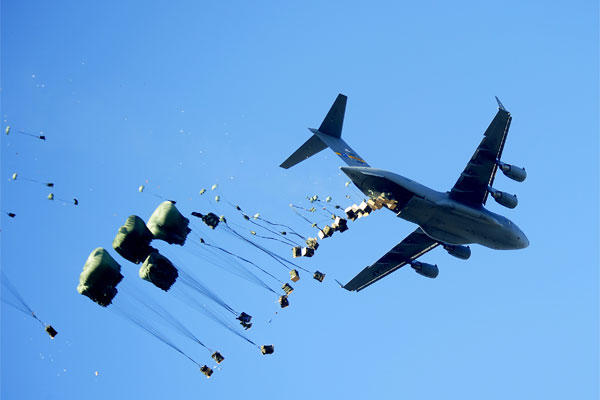SCOTT AIR FORCE BASE, Ill. -- No one wants to injure a civilian when parachuting-in life-saving supplies. But the reality is that so-called humanitarian airdrops carry inherent dangers, as massive bundles must be dropped into disaster areas, sometimes putting people on the ground at risk.
"With a typical humanitarian airdrop bundle of food and water, you're looking at a lot of weight, so it's a challenge to find a safe drop zone that gets the supplies near the people without risk of the bundle injuring someone on the ground," says Lt. Col. Tom Lankford, who is the chief of tactics for Air Mobility Command's operations directorate.
Enter an innovative idea: individual packets weighing only ounces that can flutter to the ground harmlessly enough that a disaster victim might even be able to catch one out of the air.
How to make this innovative idea work was the focus of mobility Airmen who met recently as part of the Airlift Tanker Association symposium in Anaheim, Calif., Nov. 1-4. Exploring this radical transformation at the conference were Air Force and Army experts like Lankford who understand the intricacies of humanitarian relief operations.
One such method involves individual foam packages called Humanitarian Operations Packaged Essentials, or HOPE, packages.
Lankford said inside each HOPE package contains 6 ounces of water or an energy bar - enough to help sustain a person during a humanitarian crisis. He said the goal would be to drop 125,000 HOPE packages - enough to cover a city - from a C-17 in one aerial pass.
"HOPE packages only weigh six ounces," said Lankford. "We've conducted tests to ensure they fall to the ground much slower - there's no danger of injury to someone on the ground."
Also in development is the Hydropack - a rather remarkable package that someone can drop in dirty water, wait for the built-in filtration bag to soak up the dirty water, and in minutes get a safe, drinkable liquid similar to a sports drink.
"Experiences in relief operations like Operation Unified Response in Haiti showed us people are far more desperate to get water versus food in the opening hours a disaster situation," said Lankford. "Hydropacks not only allow us to get water safely to those in need, but also to get it right to them, so they don't have to go to a (distant) drop zone, which could be dangerous."
Lankford said the United States Agency for International Development, also known as USAID, is the lead Federal agency for delivering humanitarian assistance to other countries. AMC and joint service partners are working with USAID to see if HOPE packages and Hydropacks can be incorporated into humanitarian relief operations around the globe.




























